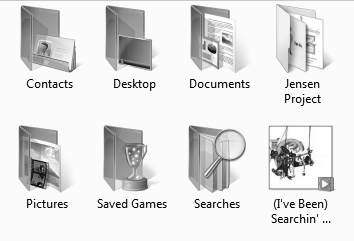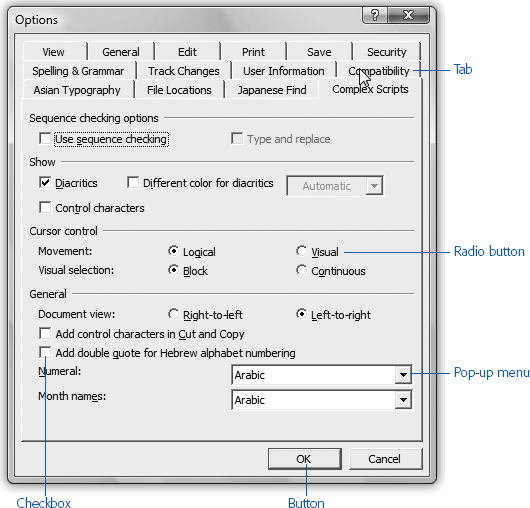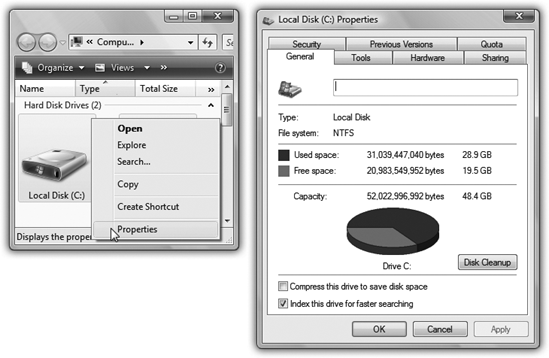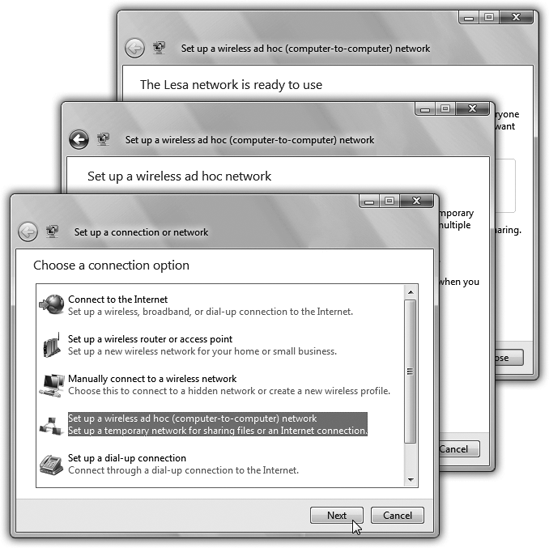Chapter 1. THE VERY BASICS
As any good teacher can tell you, it’s best not to put the cart before the horse—or to start flinging computer jargon around without first explaining the lay of the land. And with Windows Vista, there’s a heck of a lot of land to survey. The following pages don’t actually show you how to do very much—but the do prepare you, psychologically and philosophically, for what your Windows PC holds in store.
About Windows
Windows is an operating system, the software that controls your computer. It’s designed to serve you in several ways:
▸ It’s a launching bay. At its heart, Windows is a home base, a remote-control clicker that lets you call up the various software programs (applications) you use to do work or kill time. When you get right down to it, applications are the real reason you bought a PC.
Windows Vista is a well-stocked software pantry unto itself; for example, it comes with a Web browser, email program, simple word processor, and calculator. Vista comes with a suite of games, too.
If you were stranded on a desert island, the built-in Windows programs could suffice for everyday operations. But if you’re like most people, sooner or later, you’ll buy and install more software. That’s one of the luxuries of using Windows: you can choose from a staggering number of add-on programs. Whether you’re a left-handed beekeeper or a German-speaking nun, some company somewhere is selling Windows software designed just for you, its target audience.
▸ It’s a file cabinet. Every application on your machine, as well as every document you create, is represented on the screen by an icon, a little picture that symbolizes the underlying file or container. You can organize these icons into onscreen file folders. You can make backups (safety copies) by dragging file icons onto a floppy disk or blank CD, or send files to people by email. You can also trash icons you longer need by dragging them onto the Recycle Bin icon.
▸ It’s your equipment headquarters. What you can actually see of Windows is only the tip of the iceberg. An enormous chunk of Windows is behind-the-scenes plumbing that controls the various functions of your computer—its modem, screen, keyboard, printer, and so on.
Mouse and Keyboard Essentials
To use almost any kind of computer, you need to know a few basics. You won’t get far without mastering a few terms and concepts:
▸ Clicking. This book gives you three kinds of instructions that require you to use the Mac’s mouse. To click means to point the arrow cursor at something on the screen and then—without moving the cursor—press and release the clicker button on the mouse (or your laptop trackpad). To double-click, of course, means to click twice in rapid succession, again without moving the cursor at all. And to drag means to move the cursor while holding down the button.
When you’re told to Ctrl-click something, you click while pressing the Ctrl key (which is next to the Space bar). Shift-clicking and Alt-clicking work the same way—just click while pressing the corresponding key.
▸ Icons. The colorful inch-tall pictures that appear in your various desktop folders are the graphic symbols that represent each program, disk, and document on your computer. See Figure 1-1.
Figure 1-1. These are just a few of the icons you’ll encounter in Window. If you click an icon one time, it darkens, indicating that you’ve just highlighted or selected it. Now you’re ready to manipulate it by using, for example, a menu command. If you double-click an icon, on the other hand, you open it (usually into a window or a program).▸ Menus. The menus are the words that appear in a row at the top of many windows: File, Edit, and so on. Click one to make a list of commands appear.
Some people click and release to open a menu and then, after reading the choices, click again on the one they want. Other people like to press the mouse button continuously after the initial click on the menu title, drag down the list to the desired command, and only then release the mouse button. Either method works fine.
▸ Keyboard shortcuts. If you’re typing along in a burst of creative energy, it’s disruptive to have to grab the mouse to use a menu. That’s why many experienced PC fans prefer to trigger menu commands by pressing certain combinations on the keyboard. For example, in word processors, you can press Ctrl+B to produce a boldface word. When you read an instruction like “press Ctrl+B,” start by pressing the Ctrl key; then, while it’s down, type the letter B; and finally release both keys.
▸ Checkboxes, radio buttons, tabs. See Figure 1-2 for a quick visual reference to the onscreen controls you’re most often asked to use.
The Right Mouse Button is King
One of the most important features of Windows isn’t on the screen—it’s under your hand. The standard mouse has two mouse buttons. You use the left one to click buttons, highlight text, and drag things around on the screen.
When you click the right button, however, a shortcut menu appears onscreen, like the ones shown in Figure 1-3. Get into the habit of right-clicking things—icons, folders, disks, text in your word processor, buttons on your menu bar, pictures on a Web page, and so on. The commands that appear on the shortcut menu will make you much more productive and lead you to discover handy functions you never knew existed.
This is a big deal: Microsoft’s research suggests that nearly 75 percent of Windows users don’t use the right mouse button, and therefore miss hundreds of timesaving shortcuts. Part of the rationale behind Windows Vista’s redesign is putting these functions out in the open. Even so, many more shortcuts remain hidden under your right mouse button.
Tip
Microsoft doesn’t discriminate against left-handers... much. You can swap the functions of the right and left mouse buttons easily enough.
Choose Start→Control Panel. Click “Classic view.” Open the Mouse icon. When the Mouse Properties dialog box opens, click the Buttons tab, and then turn on “Switch primary and secondary buttons.” Then click OK. Windows now assumes that you want to use the left mouse button as the one that produces shortcut menus.
Wizards = Interviews
A wizard is a series of screens that walks you through the task you’re trying to complete. Wizards make configuration and installation tasks easier by breaking them down into smaller, more easily digested steps. Figure 1-4 offers an example.
There’s More Than One Way to Do Everything
No matter what setting you want to adjust, no matter what program you want to open, Microsoft has provided 165 different ways to do it. For example, here are the various ways to delete a file: press the Delete key; choose File→Delete; drag the file icon onto the Recycle Bin; or right-click the file, and then choose Delete from the shortcut menu.
Pessimists grumble that there are too many paths to every destination, making it much more difficult to learn Windows. Optimists point out that this abundance of approaches means that almost everyone will find, and settle on, a satisfying method for each task. Whenever you find a task irksome, remember you have other options.
You Can Use the Keyboard for Everything
In earlier versions of Windows, underlined letters appeared in the names of menus and dialog boxes. These underlines were clues for people who found it faster to do something by pressing keys than by using the mouse.
The underlines are hidden in Windows Vista, at least in disk and folder windows. (They may still appear in your individual software programs.) If you miss them, you can make them reappear by pressing the Alt key, Tab key, or an arrow key whenever the menu bar is visible. (When you’re operating menus, you can release the Alt key immediately after pressing it.) In this book, in help screens, and computer magazines, you’ll see key combinations indicated like this: Alt+S (or Alt+ whatever the letter key is).
Note
In some Vista programs, in fact, the entire menu bar is gone until you press Alt (or F10). That includes everyday Explorer windows.
Once the underlines are visible, you can open a menu by pressing the underlined letter (F for the File menu, for example). Once the menu is open, press the underlined letter key that corresponds to the menu command you want. Or press Esc to close the menu without doing anything. (In Windows, the Esc key always means cancel or stop.)
If choosing a menu command opens a dialog box, you can trigger its options by pressing Alt along with the underlined letters. (Within dialog boxes, you can’t press and release Alt; you have to hold it down while typing the underlined letter.)
You Could Spend a Lifetime Changing Properties
You can’t write an operating system that’s all things to all people, but Microsoft has certainly tried. You can change almost every aspect of the way Windows looks and works. You can replace the gray backdrop of the screen (the wallpaper) with your favorite photograph, change the typeface used for the names of your icons, or set up a particular program to launch automatically every time you turn on the PC.
When you want to change some general behavior of your PC, like how it connects to the Internet, how soon the screen goes black to save power, or how quickly a letter repeats when you hold down a key, you use the Control Panel window (described in Chapter 6).
Many other times, however, you may want to adjust the settings of only one particular element of the machine, such as the hard drive, the Recycle Bin, or a particular application. In those cases, simply right-click the corresponding icon. In the resulting shortcut menu, you’ll often find a command called Properties. When you click it, a dialog box appears, containing settings or information about that object, as shown in Figure 1-4.
It’s also worth getting to know how to operate tabbed dialog boxes, like the one shown in Figure 1-2. These are windows that contain so many options, Microsoft has had to split them up into separate panels, or tabs. To reveal a new set of options, just click a different tab (called General, Tools, Hardware, Sharing, Security, and Quota in Figure 1-3). These tabs are designed to resemble the tabs at the top of file folders.
Every Piece of Hardware Requires Software
When computer geeks talk about their drivers, they’re not talking about their chauffeurs (unless they’re Bill Gates); they’re talking about the controlling software required by every hardware component of a PC.
The driver is the translator between your PC’s brain and the equipment attached to it: mouse, keyboard, screen, DVD drive, scanner, digital camera, palmtop, and so on. Without the correct driver software, the corresponding piece of equipment doesn’t work at all.
When you buy one of these gadgets, you receive a CD containing the driver software. If the included driver software works fine, then you’re all set. If your gadget acts up, however, remember that equipment manufacturers regularly release improved (read: less buggy) versions of these software chunks. (You generally find such updates on the manufacturers’ Web sites.)
Fortunately, Windows Vista comes with drivers for over 12,000 components, saving you the trouble of scavenging for them on a disk or on the Internet. This gigantic library is the heart of Microsoft’s Plug and Play feature, which lets you connect a new gadget to your PC without even thinking about the driver software (Chapter 12).
It’s Not Meant to Be Overwhelming
Windows has an absolutely staggering array of features. You can burrow six levels down, dialog box through dialog box, and never come to the end of it. There are enough programs, commands, and help screens to keep you studying the rest of your life.
It’s crucial to remember that Microsoft’s programmers created Windows in modules—the digital-photography team here, the networking team there—with different audiences in mind. The idea, of course, was to make sure that no subset of potential customers would find a feature lacking.
But if you don’t have a digital camera, a network, or whatever, there’s absolutely nothing wrong with ignoring everything you encounter on the screen that isn’t relevant to your setup and work routine. Not even Microsoft’s CEO uses every single feature of Windows Vista.
Get Windows Vista for Starters: The Missing Manual now with the O’Reilly learning platform.
O’Reilly members experience books, live events, courses curated by job role, and more from O’Reilly and nearly 200 top publishers.





